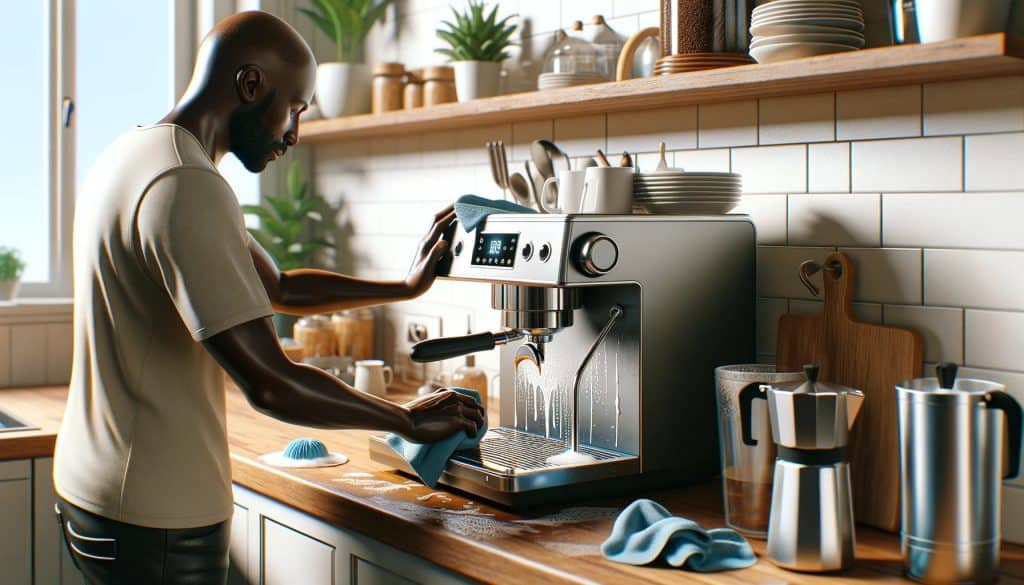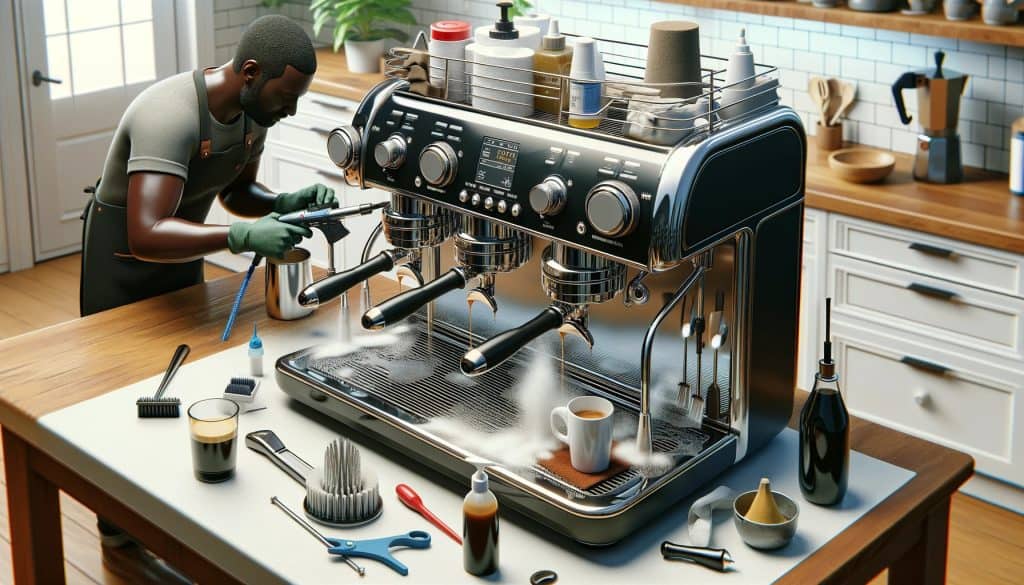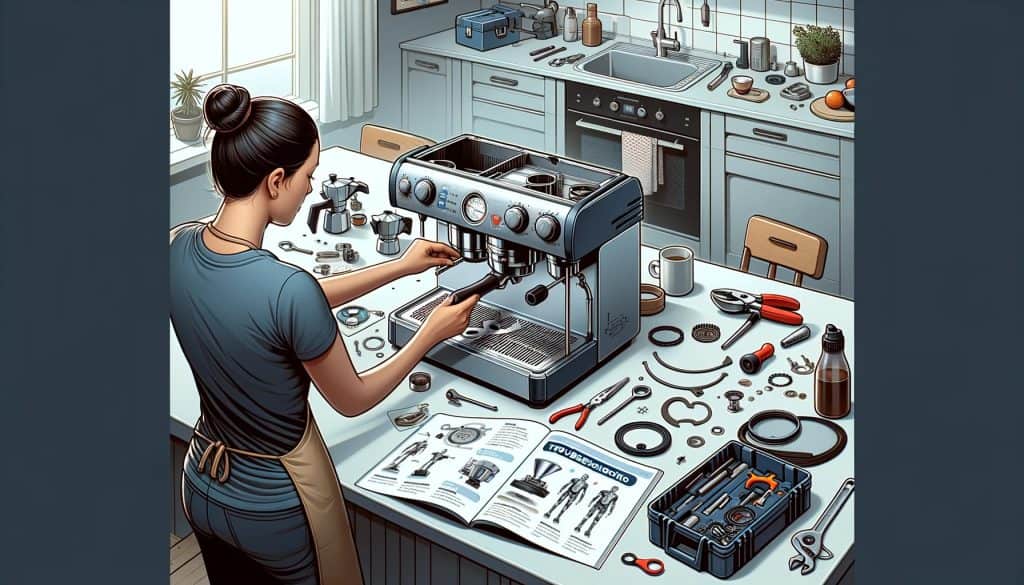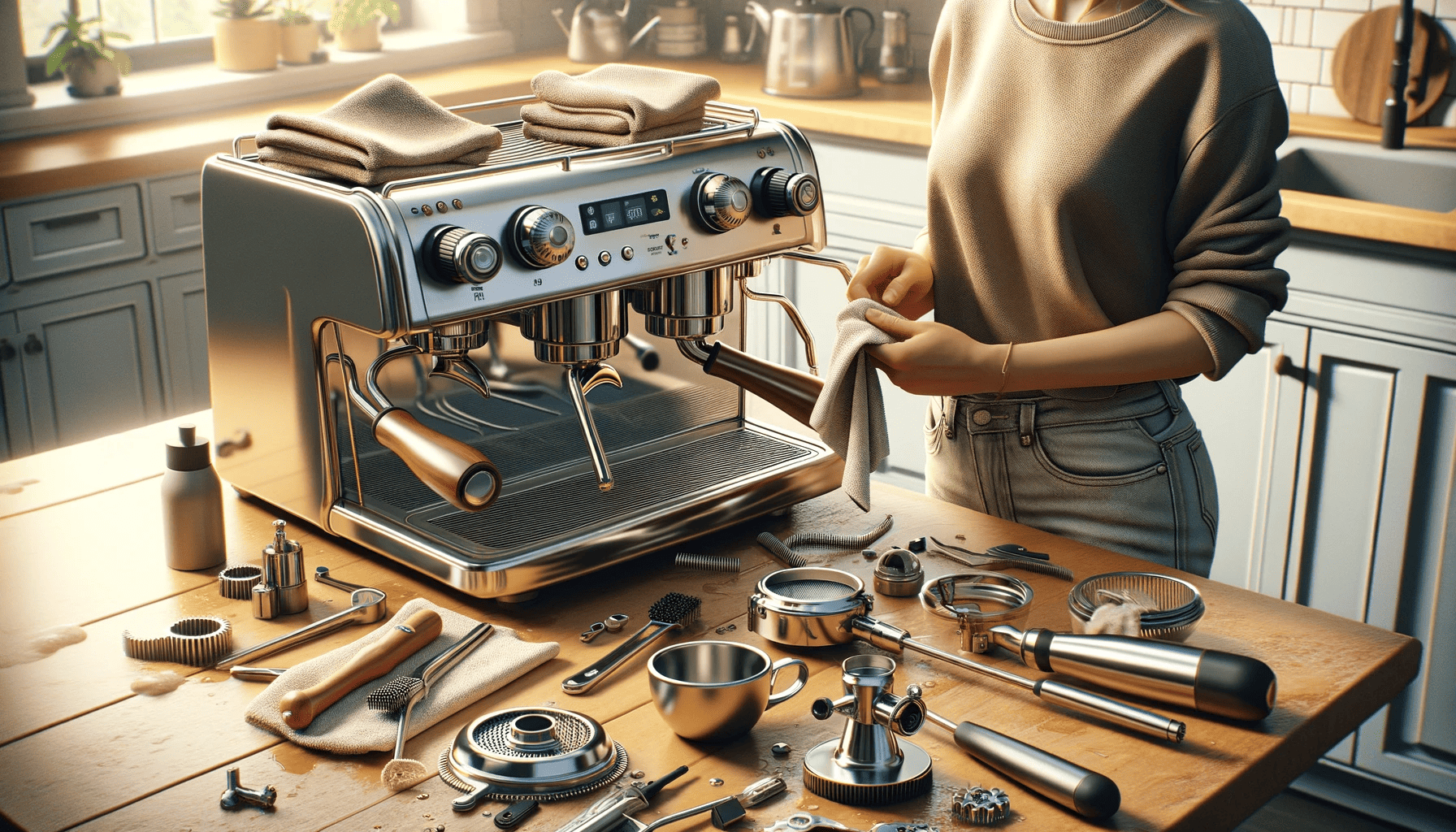As a passionate coffee enthusiast, I firmly believe in the mantra, “take care of your espresso machine, and it will take care of your coffee.”
The ritual of maintaining an espresso machine might seem like a chore to some, but it’s a practice that pays off in spades. Let me take you t ough why this often-overlooked aspect is critical for any home barista.
The Essence of Maintenance: Beyond a Simple Clean
Maintaining an espresso machine isn’t just about keeping it looking good; it’s about ensuring its longevity, taste quality, and consistent performance. It’s like caring for a classic car – regular tune-ups keep it running smoothly and preserve its value.
Maintenance Benefits
| Benefit | Description | Impact on Espresso Machine |
|---|---|---|
| Longevity | Regular cleaning and descaling prolong lifespan | Prevents wear and corrosion |
| Better Taste | Clean components ensure no residue affects flavor | Richer, purer espresso flavor |
| Consistent Performance | Regular checks maintain optimal functioning | Reliable espresso shots every time |
The Longevity Factor
An espresso machine is an investment, and like any good investment, its value is best maintained t ough care. Regular maintenance prevents common issues like mineral buildup and wear on seals and gaskets, which can lead to costly repairs or even the need for a premature replacement.
List of Common Issues Prevented by Maintenance:
- Scale buildup in the boiler
- Clogged water lines
- Worn out seals and gaskets
- Electrical malfunctions due to moisture
- Deterioration of the heating element
Taste: The Heart of Espresso
Let’s talk taste – the soul of your espresso. Oils and residues from coffee beans can linger in your machine, affecting the flavor of your brew. A well-maintained machine ensures that every cup of espresso is as fresh and flavorful as intended.
Quick Tips for Flavor Preservation:
- Clean the portafilter and basket after every use.
- Backflush semi-automatic machines regularly.
- Use filtered water to prevent mineral buildup.
Consistency: The Barista’s Dream
Finally, there’s the joy of consistency. There’s nothing more satisfying than an espresso machine that delivers perfect shots every single time. Regular maintenance keeps the machine’s pressure and temperature in check, ensuring consistent quality.
Checklist for Consistent Performance:
- Regularly check and calibrate the pressure gauge.
- Monitor the machine’s temperature stability.
- Replace water filters as recommended.
- Descale the machine every 3-6 months.
So as you can see, maintaining an espresso machine might seem daunting, but it's a rewarding practice that enhances the life of the machine, the quality of your coffee, and the reliability of each shot. Embrace this journey, and you'll not only become a better barista but also develop a deeper appreciation for the art of espresso making.< class="wp-block-separator has-alpha-channel-opacity"/>
Understanding Your Espresso Machine: A Comprehensive Guide
Embarking on the journey of home espresso brewing is t illing but can be a bit overwhelming. Understanding your espresso machine is the first step towards mastering the art of espresso. Let’s dive into the different types of machines and their nuances, especially focusing on their maintenance needs and key components.

Different Types of Espresso Machines
Espresso machines come in various forms, each with its unique characteristics and maintenance requirements. Knowing these differences is crucial for optimal upkeep and performance.
Types of Espresso Machines and Maintenance Needs
| Type of Machine | Maintenance Needs |
|---|---|
| Manual Lever Machines | Regular calibration, lever lubrication |
| Semi-Automatic | Backflushing, periodic descaling |
| Automatic | Cleaning of automatic frothers, descaling |
| Super-Automatic | Regular cleaning of grinders, descaling |
| Capsule Machines | Cleaning of capsule holders, descaling |
Key Maintenance Highlights:
- Manual Lever Machines: These require careful calibration and occasional lubrication of the lever mechanism.
- Semi-Automatic: Known for their backflushing needs and periodic descaling to prevent mineral buildup.
- Automatic and Super-Automatic: These machines often have built-in grinders and milk frothers, which need regular cleaning.
- Capsule Machines: Simple in design, but the capsule holders and water reservoir still require consistent cleaning and descaling.
Identifying Key Components
Understanding the components of your espresso machine enhances your ability to maintain it effectively. Here’s a breakdown of the key parts:
List of Key Components and Descriptions
- Portafilter: This handle and basket hold the coffee grounds and is where water passes t ough to extract espresso. Regular cleaning is essential to prevent old coffee oils from spoiling your brew.
- Steam Wand: Used for frothing milk. It requires immediate cleaning after each use to prevent milk residue buildup.
- Group Head: The part where the portafilter attaches. It should be cleaned regularly to ensure a clean water path.
- Water Reservoir: Needs to be refilled with fresh water and cleaned periodically to prevent mold and scale.
- Drip Tray: Collects spills and needs regular emptying and cleaning.
- Grinder (if applicable): For machines with built-in grinders, regular cleaning ensures consistent grind quality.
Maintenance Tips for Key Components:
- Portafilter: Clean after every use and backflush (if applicable) with a blank basket.
- Steam Wand: Wipe and purge after every use to clear milk residue.
- Group Head: Use a group head brush to clean and backflush with a cleaning solution regularly.
- Water Reservoir: Refill with fresh water daily and descale as per the manufacturer’s instructions.
- Drip Tray: Empty and wash regularly to prevent odor and buildup.
Understanding your espresso machine is not just about knowing how to operate it. It’s about recognizing the type of machine you have, its specific maintenance needs, and being familiar with each component and how to care for it. This knowledge not only prolongs the life of your machine but also ensures that every cup of espresso you brew is of the highest quality.< class="wp-block-separator has-alpha-channel-opacity"/>
Daily Maintenance Routines for Your Espresso Machine
Regular maintenance is the key to keeping your espresso machine in top shape. By establishing a daily routine, you can ensure your machine continues to produce delicious espresso and lasts for years. Let’s focus on the essential tasks for daily upkeep, particularly cleaning after each use and maintaining the water reservoir.

Also see: Espresso Machine For Home Under $250 At Amazon
Cleaning After Each Use
Cleaning your espresso machine after every brewing session is crucial. It prevents the buildup of coffee oils and residues, which can affect the taste of your espresso and the longevity of your machine.
Steps for Wiping Down and Cleaning Key Parts
- Portafilter: Remove any used coffee grounds and rinse the portafilter and basket under hot water.
- Group Head: Wipe around the group head with a damp cloth to remove coffee residue.
- Steam Wand: Immediately after use, wipe the wand with a damp cloth and purge steam to clear any milk residue inside.
- Drip Tray: Empty and rinse the drip tray to remove coffee spills and residues.
- Exterior: Wipe down the machine’s exterior with a soft, damp cloth to keep it looking new.
Important Tips:
- Use non-abrasive cloths to avoid scratching any surfaces.
- For machines with a backflushing capability, perform a water backflush at the end of the day.
Water Reservoir Maintenance
The water reservoir is a critical component of your espresso machine. Proper care ensures that you always brew with fresh, clean water, which is essential for great-tasting espresso.
Importance of Using Filtered Water and Regular Cleaning
- Filtered Water: Always use filtered water to fill the reservoir. This reduces mineral buildup inside the machine and enhances the taste of your espresso.
- Regular Cleaning: Empty and refill the water reservoir daily to prevent stagnant water. Clean the reservoir with mild soap and water weekly to prevent mold and lime scale.
Water Reservoir Maintenance Steps:
- Daily Refill: Empty any remaining water and refill with fresh, filtered water every day.
- Weekly Cleaning: Remove the reservoir, wash with mild soap, rinse thoroughly, and dry before replacing.
- Monthly Descaling: Depending on your water hardness, descale the reservoir and machine to prevent mineral buildup.
Key Points:
- Never use tap water directly if it’s hard or has a strong taste or odor.
- Regular descaling is crucial, especially in areas with hard water.
By integrating these cleaning and maintenance routines into your daily coffee ritual, you ensure that your espresso machine remains a reliable and efficient partner in your coffee journey. Not only does this daily care routine keep your machine in pristine condition, but it also guarantees that each cup of espresso you brew is as delicious as the last.< class="wp-block-separator has-alpha-channel-opacity"/>
Weekly and Monthly Maintenance Tasks for Your Espresso Machine
Proper maintenance of your espresso machine extends beyond daily routines. Weekly and monthly tasks are crucial for the longevity and performance of your machine. Let’s delve into the specifics of backflushing semi-automatic and automatic machines, as well as cleaning the grinder and drip tray.

Backflushing Semi-Automatic and Automatic Machines
Backflushing is a vital maintenance step for semi-automatic and automatic espresso machines with a t ee-way solenoid valve. It helps to remove coffee oil residue and grounds from the group head and valve.
Step-by-Step Guide to Backflushing
- Frequency: Perform backflushing once a week for home use, or daily in a commercial setting.
- Process:
- Insert a blind filter in the portafilter.
- Add a teaspoon of espresso machine cleaner into the blind filter.
- Lock the portafilter into the group head.
- Run the brew cycle for about 5 seconds, then pause for 5 seconds.
- Repeat the cycle 5-10 times until the water runs clear.
- Rinse: Remove the cleaning agent, replace it with the blind filter, and run clean water t ough the cycle several times.
Tips for Effective Backflushing
- Always use a cleaner specifically designed for espresso machines.
- Never backflush lever machines or machines without a t ee-way solenoid valve.
Cleaning the Grinder and Drip Tray
A clean grinder is essential for fresh-tasting espresso, and a clean drip tray prevents odor and mold.
Techniques and Tips for Cleaning the Grinder
- Frequency: Clean the grinder every week to ensure optimal performance.
- Process:
- Empty all the beans from the hopper.
- Use a grinder brush to clean out any remaining grounds.
- If possible, remove the burrs and clean them with a brush.
- Wipe down the hopper with a damp cloth.
- Reassembly: Ensure everything is dry before reassembling.
Tips for Maintaining Your Grinder
- Avoid using water or liquids inside the grinder.
- Regular cleaning prevents oil buildup from stale beans.
Cleaning and Maintaining the Drip Tray
- Frequency: Remove and clean the drip tray weekly.
- Process:
- Remove the tray and discard the contents.
- Wash with mild soap and warm water.
- Rinse thoroughly and dry before replacing.
Key Points for Drip Tray Maintenance
- Regular cleaning prevents mold and unpleasant odors.
- Inspect for any coffee or water leaks in the area.
By adhering to these weekly and monthly maintenance tasks, you ensure your espresso machine and grinder work efficiently and continue to produce high-quality espresso. Remember, the effort you put into maintaining your machine directly impacts the quality of your coffee and the longevity of the equipment.< class="wp-block-separator has-alpha-channel-opacity"/>
Deep Cleaning and Descaling Your Espresso Machine
Maintaining your espresso machine isn’t just about the daily wipe-downs or weekly backflushes. Deep cleaning and descaling are crucial processes to ensure your machine operates at its best. Let’s dive into the when and how of descaling and the specifics of deep cleaning the brew group and steam wand.

When and How to Descale
Descaling is vital to remove mineral buildup (scale) inside your machine, especially if you use hard water.
Identifying Signs of Scale Buildup
- Reduced Water Flow: If the water from your espresso machine is flowing slower than usual, it could be due to scale.
- Strange Noises: Unusual sounds from your machine may indicate scale affecting the heating elements.
- Poor Coffee Quality: Scale can affect the temperature and taste of your coffee.
Descaling Process
- Frequency: Descale every 3-6 months, depending on water hardness and machine usage.
- Steps:
- Use a descaling solution specifically made for espresso machines.
- Mix the solution with water as per the instructions and fill the water reservoir.
- Run part of the solution t ough the steam wand, group head, and hot water spout.
- Let the machine sit for 20-30 minutes (or as advised by the descaling solution).
- Flush the entire system with the solution, and then run fresh water t ough multiple times to rinse.
Deep Cleaning the Brew Group and Steam Wand
Regular deep cleaning of the brew group and steam wand is necessary to maintain the taste of your espresso and the functionality of your machine.
Deep Cleaning the Brew Group
- Frequency: Clean monthly or bi-monthly, depending on usage.
- Process:
- Remove the brew group (if detachable).
- Rinse it under warm water and use a soft brush to remove coffee residue.
- For non-detachable brew groups, use a group head brush to clean around the area.
Maintaining the Steam Wand
- Frequency: Deep clean monthly, with daily wiping and purging after each use.
- Steps:
- Soak the tip of the steam wand in a solution of warm water and a small amount of espresso machine cleaner.
- Use a needle or pin to clear the holes of any blockages.
- Wipe down with a damp cloth.
- Steam t ough with water to rinse any cleaning solution.
By incorporating descaling and deep cleaning into your maintenance routine, you protect your investment and ensure that your espresso machine continues to produce delicious coffee for years to come. Regular attention to these tasks will enhance the machine's performance and the quality of the espresso it brews.< class="wp-block-separator has-alpha-channel-opacity"/>
Replacing Parts and Troubleshooting for Espresso Machines
To keep your espresso machine in top shape, it’s essential to know when to replace parts and how to troubleshoot common issues. This ensures not only the longevity of the machine but also the quality of your espresso.

Commonly Replaced Parts
Certain parts of your espresso machine will wear out over time and require replacement. Knowing when and how to replace these parts is crucial.
When and How to Replace Parts
- Gaskets and Seals:
- When: Replace annually or when you notice leaks or a drop in pressure.
- How: Turn off and unplug the machine, disassemble the portafilter head, remove the old gasket using a screwdriver or a gasket pick, and fit in the new gasket.
- Water Filters:
- When: Every 2-3 months or as recommended by the manufacturer.
- How: Locate the filter compartment, remove the old filter, and replace it with a new one.
- Shower Screens:
- When: If you notice a decrease in water dispersion or coffee quality.
- How: Unscrew the old shower screen, clean any residue, and screw in a new screen.
- Steam Wand Tips:
- When: If clogging becomes a frequent issue or the steam power decreases.
- How: Unscrew the old tip, clean the wand, and attach a new tip.
Troubleshooting Common Issues
Addressing common issues promptly can prevent larger problems down the line.
Addressing Issues
- Clogging:
- Cause: Coffee oil buildup or fine coffee grounds.
- Solution: Regularly clean and descale the machine. Use a needle to unclog the holes in the portafilter or steam wand.
- Leaks:
- Cause: Worn out gaskets or loose connections.
- Solution: Replace gaskets and seals, and ensure all connections are tight.
- Inconsistent Espresso Shots:
- Cause: Can range from grind size issues to machine temperature fluctuations.
- Solution: Check your grind size, ensure even tamping, and ensure the machine is properly warmed up. Consider descaling if the problem persists.
Regularly replacing worn parts and addressing issues as they arise will keep your espresso machine running smoothly. This proactive approach not only prevents disruptions in your coffee routine but also extends the lifespan of your machine. By staying on top of these tasks, you ensure that your espresso machine remains a reliable and enjoyable part of your daily life.< class="wp-block-separator has-alpha-channel-opacity"/>
Professional Servicing and Support for Espresso Machines
Even with regular maintenance, there may be times when professional help is needed to keep your espresso machine in optimal condition. Knowing when to seek professional servicing and how to find reliable service providers can save you from unnecessary headaches and ensure your machine continues to produce the best espresso.

When to Seek Professional Help
Understanding the signs that indicate the need for professional servicing is key to preventing more severe issues with your espresso machine.
Identifying Problems That Require a Professional
- Persistent Performance Issues:
- If problems like irregular water temperature, pressure issues, or inconsistent espresso quality persist despite troubleshooting, professional inspection is advised.
- Electrical Problems:
- If you notice any electrical issues, such as the machine not turning on, frequent power surges, or electrical smells, immediately seek professional help.
- Water Leakage:
- Significant water leaks, especially around electrical components, require immediate attention from a professional.
- Unusual Noises:
- Grinding, banging, or hissing sounds can indicate internal problems that need a professional’s expertise.
Finding Reliable Service Providers
Choosing the right service provider is crucial for the well-being of your espresso machine. Here are some tips to help you find a reliable technician.
Tips for Choosing a Service Provider
- Check Credentials and Experience:
- Look for service providers who specialize in espresso machines and have a proven track record. Check their certifications and experience with your specific machine brand and model.
- Read Reviews and Testimonials:
- Online reviews and testimonials can provide insights into the quality of service provided. Pay attention to comments about professionalism, turnaround time, and problem resolution.
- Ask for Recommendations:
- Get recommendations from other espresso enthusiasts or local coffee shops. Personal referrals often lead to trustworthy and competent service providers.
- Inquire About Warranty and Services Offered:
- Choose a service provider who offers a warranty on their work. Ensure they provide the specific services your machine needs, like descaling, part replacements, or electrical repairs.
- Compare Pricing:
- Get quotes from multiple service providers to ensure you’re getting a fair price. However, don’t base your decision on price alone; quality service is often worth the extra cost.
By recognizing when your espresso machine requires professional servicing and knowing how to select a reliable service provider, you can ensure your machine gets the care it needs. This not only extends its lifespan but also ensures that it continues to produce high-quality espresso, enhancing your coffee experience at home.< class="wp-block-separator has-alpha-channel-opacity"/>
Conclusion: The Key to a Superior Espresso Experience
Maintaining your espresso machine might seem like a chore, but it’s a crucial step towards ensuring that every cup of coffee you brew is as perfect as it can be.
In this guide, we’ve walked t ough the various aspects of espresso machine care, from daily routines to deep cleaning and professional servicing. Let’s recap the key points to remember:

- Regular Maintenance is Essential:
- Daily and weekly routines, like wiping down parts and backflushing, go a long way in preserving your machine’s condition.
- Understand Your Machine:
- Different types of espresso machines have unique maintenance needs. Knowing your machine’s specific requirements is critical.
- Deep Cleaning and Descaling:
- Regular deep cleaning and descaling are necessary to prevent scale buildup and ensure the longevity of your machine.
- Be Proactive with Part Replacements:
- Replacing parts like gaskets and seals before they completely wear out can prevent more significant issues.
- Seek Professional Help When Needed:
- Some problems are best left to professionals. Knowing when and how to seek professional help can save you time and protect your machine.
- Maintenance Ensures Quality:
- Regular maintenance not only prolongs the life of your espresso machine but also ensures that each cup of espresso you brew is of the highest quality.
In conclusion, the secret to enjoying the best espresso experience at home isn't just about the beans you choose or the machine you own; it's also about how well you take care of that machine. Regular maintenance is not just a responsibility; it's a ritual that enhances the quality and taste of your espresso, making every sip worth the effort. So, embrace the process, and let each cup reflect the care and attention you’ve invested in your espresso machine.


